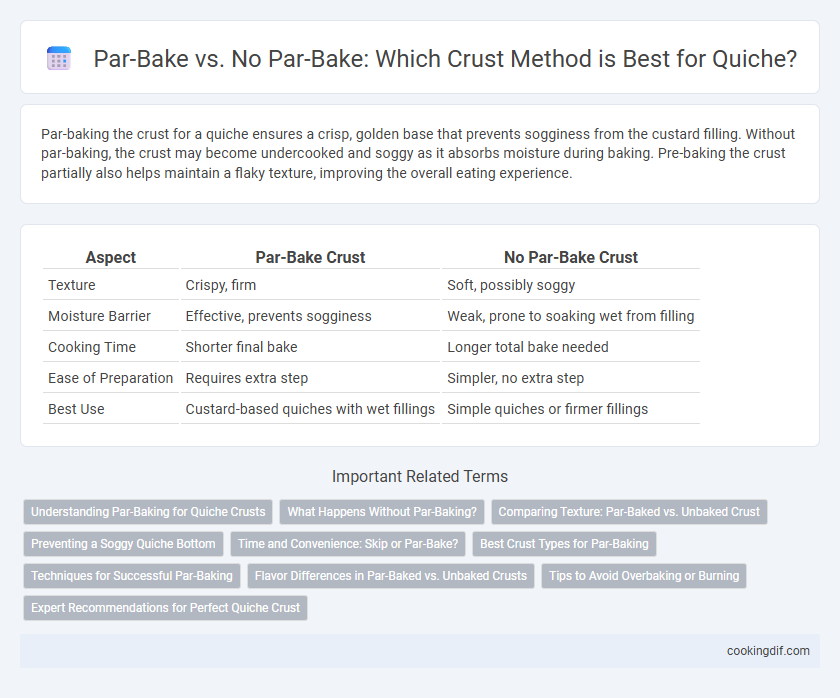Par-baking the crust for a quiche ensures a crisp, golden base that prevents sogginess from the custard filling. Without par-baking, the crust may become undercooked and soggy as it absorbs moisture during baking. Pre-baking the crust partially also helps maintain a flaky texture, improving the overall eating experience.
Table of Comparison
| Aspect | Par-Bake Crust | No Par-Bake Crust |
|---|---|---|
| Texture | Crispy, firm | Soft, possibly soggy |
| Moisture Barrier | Effective, prevents sogginess | Weak, prone to soaking wet from filling |
| Cooking Time | Shorter final bake | Longer total bake needed |
| Ease of Preparation | Requires extra step | Simpler, no extra step |
| Best Use | Custard-based quiches with wet fillings | Simple quiches or firmer fillings |
Understanding Par-Baking for Quiche Crusts
Par-baking quiche crusts involves partially baking the dough before adding the filling to prevent sogginess and ensure a crisp, golden base. This technique solidifies the crust structure, reducing moisture absorption from the custard filling and maintaining texture throughout baking. Skipping par-baking may result in a softer, less stable crust, often leading to a watery or undercooked bottom that diminishes the overall quality of the quiche.
What Happens Without Par-Baking?
Without par-baking, quiche crust often becomes soggy as the custard filling seeps into the dough, preventing a crisp texture. The crust may also cook unevenly, resulting in a doughy or underbaked bottom that compromises overall flavor and structure. Par-baking creates a barrier that locks in the crust's integrity, ensuring a firmer, more desirable texture in the finished quiche.
Comparing Texture: Par-Baked vs. Unbaked Crust
Par-baking a quiche crust results in a firmer, crispier texture that prevents sogginess by sealing the dough before adding the filling. Unbaked crusts tend to absorb moisture from the custard, leading to a softer, sometimes soggy base. Choosing par-bake ensures a golden, flaky crust contrast to the creamy quiche interior, enhancing overall mouthfeel and structure.
Preventing a Soggy Quiche Bottom
Par-baking the crust for 5 to 10 minutes at 375degF helps create a barrier that prevents moisture from the quiche filling from soaking into the crust, crucial for a crisp quiche bottom. Skipping the par-bake often results in a soggy, undercooked base due to the custard mixture seeping into raw dough during baking. Using a pie shield or weighing down the crust edges can further improve structural integrity and reduce steam buildup.
Time and Convenience: Skip or Par-Bake?
Par-baking a quiche crust typically takes 10 to 15 minutes at 375degF (190degC), ensuring a crisp base that resists sogginess from the filling. Skipping par-baking saves preparation time but risks a soggy, undercooked crust due to prolonged exposure to moist custard. For optimal convenience without compromising texture, par-baking streamlines baking time by preventing a wet bottom and ensuring even doneness.
Best Crust Types for Par-Baking
Par-baking is ideal for crusts like pate brisee and shortcrust pastry, which develop a crisp, flaky texture when partially baked before filling. Using a blind-bake method with pie weights prevents sogginess in custard-rich quiches by maintaining structural integrity. Crusts with higher fat content and lower hydration, such as pate sucree, are less suitable for par-baking due to potential over-browning.
Techniques for Successful Par-Baking
Par-baking a quiche crust involves partially baking the dough before adding the filling to prevent sogginess and maintain a crisp texture. Techniques for successful par-baking include docking the crust with a fork, lining it with parchment paper, and using pie weights or dried beans to avoid puffing during baking. Removing the weights halfway through baking ensures the crust develops a golden color and optimal flakiness.
Flavor Differences in Par-Baked vs. Unbaked Crusts
Par-baking a quiche crust enhances flavor by creating a toasted, nutty taste from the Maillard reaction that an unbaked crust lacks, resulting in a richer and more complex profile. An unbaked crust often absorbs liquid from the filling, leading to a softer, sometimes soggy texture that can dilute the crust's natural buttery flavor. The choice between par-baked and unbaked crusts directly impacts the balance of crispness and flavor intensity in the finished quiche.
Tips to Avoid Overbaking or Burning
To prevent overbaking or burning quiche crust, par-baking (blind baking) is recommended, as it ensures a crisp base by partially baking the crust before adding the filling. Using pie weights during par-baking helps maintain the crust's shape and prevents shrinking or puffing. If skipping par-baking, reduce oven temperature and bake the quiche on a lower rack to allow even cooking and avoid overly browned edges.
Expert Recommendations for Perfect Quiche Crust
Expert chefs recommend par-baking quiche crust for 10-15 minutes at 375degF to prevent sogginess and ensure a crisp, flaky texture. Skipping the par-bake often results in a soggy bottom due to the wet filling soaking into the dough during baking. Using pie weights during par-baking maintains the crust's shape, creating an ideal foundation for a perfectly textured quiche.
Par-bake vs no par-bake for crust Infographic

 cookingdif.com
cookingdif.com